
29 July – 18 Aug 2006
Cochabamba – La Paz – Copacabana (Lago Titicaca)
The rhythm of one strenuous week on the bike followed by a week off was to continue. We left the luxury of our apartment in Cochabamba for a long, steep climb up to the Altiplano in the company of Alain and Felix.

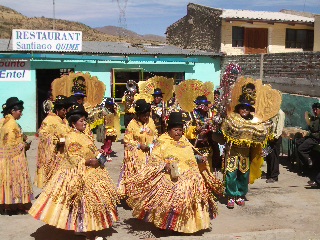
After a day and a half, we reached our first viewpoint, spiced up by a Santiago celebration of music and dance carnival style. Colourful masks and costumes completed the picture while a friendly auxiliary doled out caipirinha to guarantee a festive mood.
At this point, we let the two young lads speed ahead as we faced the altiplano in its full glory. Meaning high plane or plateau, the altiplano was somehow misnamed by someone with very limited vision and no cycling experience in the area. Considering the fact that this plateau ranges in altitude from 3500masl to 4500masl, with lots of useless ups and downs in between, we reckon it would be better called altitrabajo (high work)!


Our six days into La Paz were peppered with numerous passes above 4000masl, peaking at 4496masl. The altiplano in this area is somewhat bleak. Being winter the terraces are bare and the only activity is the herding of sheep by the local ladies in their colourful attire.
The villages themselves have little to offer hungry cyclists. Shops, when there are any, are scantily stocked with biscuits, crackers, local brand soft drinks and not a whole lot more


Accommodation is low on the ground and don’t expect running water or toilets as part of the deal. Entering these villages, we were greeted with unmanned kites, which on closer inspection were plastic bags and streamers of toilet paper. Unfortunately the UNICEF public toilets of some 10 years ago are now padlocked and surrounded by what was meant to go inside.
Along the roadside the cargo of overturned trucks is left to blend in with the desolate surroundings. Pity! ‘Cause these toilets would have come in handy!

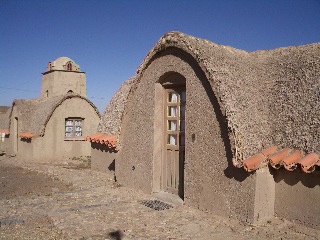
We were very positively surprised when we came upon a beautiful eco-friendly guesthouse complex in Lahuachaca. This Danish funded project is now run by locals and offers little cottages with comfortable beds and living rooms, outdoor latrines (long-drop toilets) and hot showers, which were really appreciated after four days without.

The village houses themselves are generally of dark mud bricks, in deteriorating conditions, brought to life with political propaganda. The one who invested most in all-weather colours was victorious in the last election. Six months down the line, Evo Morales, the first indigenous president in Bolivia’s 181 years, is very popular in this area.

El Alto, the fastest growing city in South America, was our gateway into La Paz. A huge urban sprawl with dense traffic of minibuses, taxis and motorbikes appeared utter chaos. However, on immersion, it was quite orderly and free flowing, letting loaded bikes in and out with a friendly smile. The nasal impression was somewhat less sublime, with a blend of roast chicken, exhaust fumes and aged urine odours to tickle the senses. Peel off this foil label for full immersion!!

El Alto, at 4100masl, provides a magnificent view into the cauldron of La Paz at 3600masl. This city of one million inhabitants is the highest capital on earth.
We free-wheeled 15km through a eucalypt forest and a bit of suburbia, ending up right down town where all the action is.

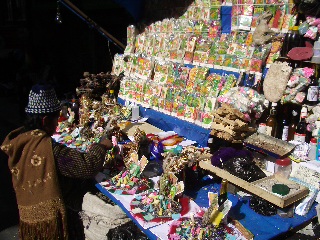
La Paz is a huge market. Every other barrio is a centre for something. Stalls tumble onto the street and you can buy absolutely anything from a street vendor. For example, in the witch market you can find all sorts of hocus pocus, while further down the street there will be alpaca socks and llama hats
Across the plaza, stalls flog bootleg CDs for one euro and at the black market you can buy back your recently stolen camera. In the food market freshly peeled guinea pigs lie side by side tropical fruit and fresh cheese…

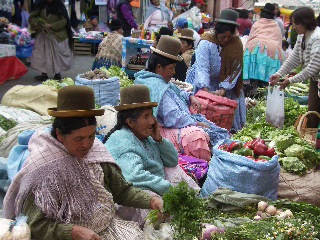
Generally the stalls are attended by indigenous ladies in their full traditional costume, topped off with some silly hat!
The llama, lamb and pig foetuses from the witch market are buried in the four corners of the foundation of houses to assure stability and durability. This market also sells numerous offerings for the Pachamama (Goddess of mother earth). They usually have a theme – for a newly married couple, for money or health. These colourful offerings are burned in the mountain in request for favours at the beginning of every month.



Marching season in Bolivia is centered on August 6th or National Day. This is the time the whole country, decked out in their Sunday best, joins a parade or two. The line out consists of all ranks of the army, navy and air force, civil servants and students, war veterans and politicians, the disabled and the blind, to name but a few.
Brass bands lead the way through throngs of spectators waving their tricolour until it’s their turn to dress up and join the parade. This definitely drives home the point that they’re mighty proud of their country. The whole event wouldn’t be complete without a gang of carnivalists in all their glory prancing to the loud beat of their repetitive tune.

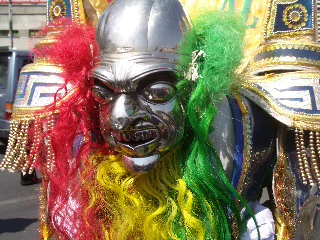

Tourists visit La Paz for numerous high-altitude adventurous activities. These include climbing, trekking, dangerous mountain biking and non-other than bible reading. We opted for the once in a life time experience of climbing a 6000masl peak.

Huayna Potosi, 6088masl, is very accessible from La Paz. Together with Alain, we headed off to the mountains and spent our first night in a refugio at 4700masl. There we had a training session with crampons and ice picks, climbing on a nearby glacier.
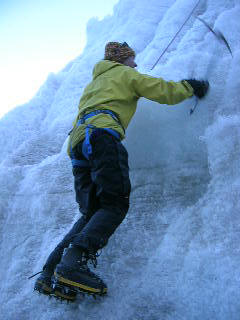
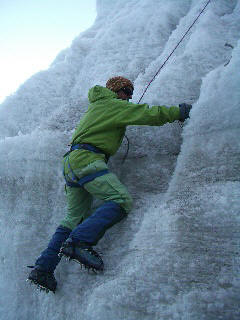
On day 2 we hiked up to our high camp at 5200masl, where the track continues on snow. After about an hour’s sleep we were called at midnight to dress up and brave the elements. Luckily, it was full moon and the starlit sky beckoned to higher ground. With Michellin layers of thermals and woolies, we headed off into the night on a very steep path. The lights of El Alto dazzled below as we pressed on in the sub zero temperatures.

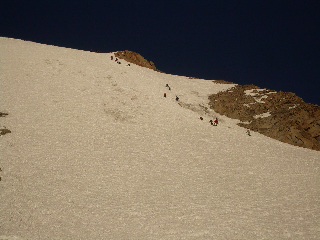
The first obstacle, beyond utter exhaustion, was a 20m ice wall which we hacked up with our crampons and ice axes. That overcome, it was another long trek ahead. By first light Darina had reached the foot of the last ice wall at 5800masl, while Kurt and Alain shivered on the summit, waiting for sunrise.
Darina thought to herself: Enough of this for a game of soldiers! And took up position to photograph the Swiss summit stormers on their descent! This turned out to be a very good move as Alain’s battery froze and Kurt’s pictures were pathetic!
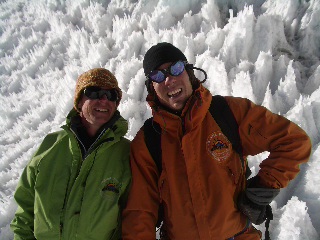


Some people call this fun; others find it addictive. Darina reckons anything that deprives her of a full 8-10 hours sleep is torture, while Kurt is quite proud of his bragging rights!
Back in La Paz, we enjoyed again the company of ten touring cyclists and good restaurants to fatten up for the next leg. Exotic dishes this time included our first fried guinea pig!


In El Alto we were very pleased to discover a real altiplano that was actually flat in the direction of Lake Titicaca. This huge 9,000Km2 expanse of deep blue is the highest navigable lake on earth, lying at 3,800masl. After so much yellow and brown it was great to have another colour on the palette.
On the way, we encountered a festival for the feast of the Assumption (Aug 15), with music, dance and lots of beer. The road was blocked so we just had to join the parade, dancing with the bikes to cheers from the crowd and VIP stand.
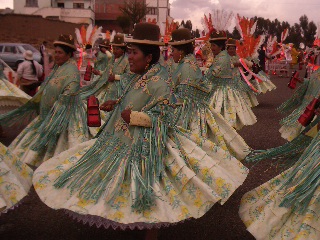


Copacabana is a popular pilgrimage destination in adoration of the wooden virgin in the spectacular Moorish cathedral. What makes it unusual is that trucks, cars, buses and motorbikes line up three times a day for their annual blessing.
First the Franciscan Friar comes out and does a thorough sprinkling of holy water on the engine, interior, wheels, and boot of the gaudily decorated vehicles. Then the local sorceress does her bit with an incense burner and lots of shaking of hands.
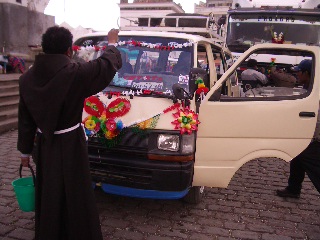

After that for good measure the driver and family spray the vehicle and themselves with sacrificial beer/champagne and plaster themselves with confetti before drinking what the car can’t absorb!
All is not complete without a gander up the steps of the stations of the cross to a viewpoint over the harbour.


There, fake dollars, euros, miniature cars, computers and houses can be purchased. These are then piled high and offered as petitions for their material desires for the coming year. A local gift of the gab accepts a tip for rhyming off a litany of saints who will deliver the millions requested.
The ritual is completed with more sprinkling and drinking of beer and champagne… with lucky froth smeared into pockets and wallets, to be sure, to be sure! Most of the cars had Peruvian registrations which should have been a warning to us about things to come…

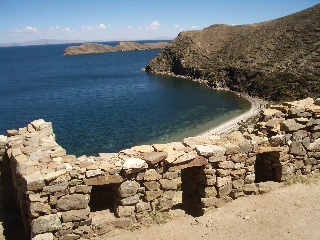
Isla del Sol, on Lake Titicaca is reputedly the birthplace of the Incas. This vehicle-free island of 11km by 6km contains a number of ruins from foregone days, but most impressive are the costal views from the central Inca trail through the island.

Bolivian drivers are generally friendly, respectful and leave lots of space for cyclists, but hoot their horns at everything that moves. Guess that’s why we never came across a drive-in cinema here!


This was a grand finale to our two months in this varied land. Bolivia is certainly a country of extremes, amazing landscapes, enchanting colonial towns, happening cities, colourful markets, sleepy dogs and reserved, but friendly and very honest people. However, it does come at a price… high altitudes and long distances make Bolivia quite the challenge for cyclists.
